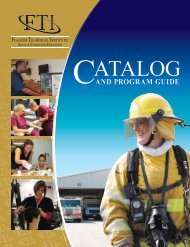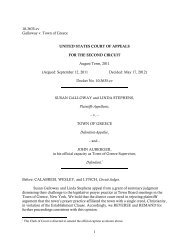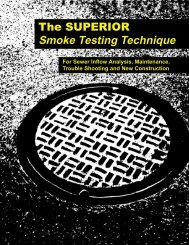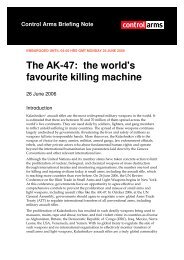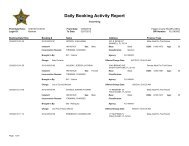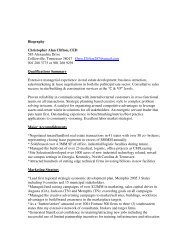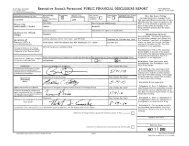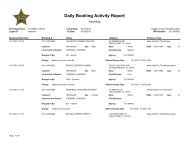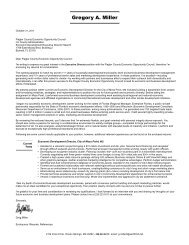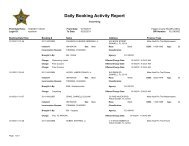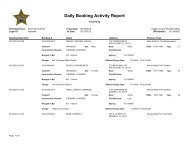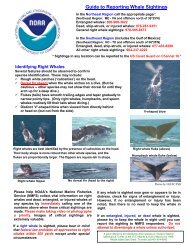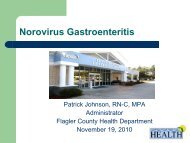Výsledková listina a pÅehled úkolů Rallye RejvÃz 2010
Výsledková listina a pÅehled úkolů Rallye RejvÃz 2010
Výsledková listina a pÅehled úkolů Rallye RejvÃz 2010
You also want an ePaper? Increase the reach of your titles
YUMPU automatically turns print PDFs into web optimized ePapers that Google loves.
Házená D RLP Rozhodčí:<br />
D RZP Rozhodčí:<br />
Handball D INT Judges:<br />
Time limit for task:<br />
max. 12 min.<br />
Daniel Csomor, Barbora Zuchová RALLYE REJVÍZ <strong>2010</strong><br />
Branislav Podhoranský, Dana Nosovská<br />
Christoph Redelsteiner, Simona Slezáková<br />
Story get to team at task start.<br />
•<br />
•<br />
•<br />
•<br />
A<br />
B<br />
C<br />
D<br />
Story for team:<br />
Dispatch centre received emergency call:<br />
Emergency call is received by the dispatcher at 15.35. The troubled mum of Juraj/Katka complains that she is not able to get her son/daughter from the bed. The patient vomited once earlier and<br />
then went to sleep. At the moment the patient Is laying in the bed, breathing normally but refusing any bodily contact or any change in body position. The worried mother insists on immediate<br />
medical help (she is worried that her child has eaten "something" in the school earlier that day). As the GP cannot come earlier than 30 minutes the dispatcher is sending out an ambulance with<br />
a crew.<br />
Your task:<br />
examine and evaluate condition of patient<br />
determine operative diagnosis and differential diagnosis,<br />
administer the therapy,<br />
when hospitalization needed, set up patient for a transport, define direction and next procedure<br />
Local situation:<br />
Nearest hospital is 20 km by ground transport with surgery, internal medicine (neurologists on duty nonstop),gynecology and obstetric and biochemistry.<br />
Higher level hospital 42 km by ground transport, dept. as A + ED, anaesthesia and General Intensive Care, ENT, CT, neurologic dept. with ICU, psychiatry, infectious diseases and pediatric dept.<br />
Specialized centre 55 km by ground. Depts. as B + traumacentre, burn unit, cardiocentre, stroke unit, NMR.<br />
Helicopter rescue available at 15 mins.<br />
Situation:<br />
8-years-old Jurko/Katka is laying covered by his/her blanket on the bed. The patient is not responding to greetings, opens eyes in response to painful stimuli but closes them immediately afterwards<br />
(photophobia). Patient's speech is slurred (words cannot be understood), physically defends and protects him/herself, (GCS 10-11 bb.) and falls straight to sleep. Body temperature is 37.2 °C(99F), limbs are<br />
cold, blood pressure is 90/50, heart beat rate is 110/min, oxygen saturation is 96 %. Isocoria is present, moderate nuchal rigidity, ptechial rash at the inner side of the thighs. Box of opened Paracetamol with 2<br />
empty blister packages is on the bedside table. Bottle of mineral water is standing next to the bed. After the 4th minute patient suffers grand-mal lasting 30 seconds followed by unconsciousness, GCS 6-7. The<br />
mother tells the crew that after coming home from school Jurko/Katka had a headache, vomited once and had a fever which wasn't checked with thermometer. To a question if the patient have eaten all the<br />
missing pills from the box the Mother answered that she gave him/her only two tablets which left from before and that these were the only pills left in the package. This was two hours ago. Then he/she had a drink and fell asleep.<br />
He/she is not treated for any illnesses. However, in his/her childhood he/she used to suffer from Febrile Seizures. He/She plays Handball for a local village Handball club. Today he/she was supposed to have<br />
training and this is why they are trying to get him/her from the bed. During the patient's seizures she non-aggressively tries to persuade the crew not to intervene because she knows this situation from before.<br />
She thinks he/she will get better shortly, everything will be fine and Jurko/Katka can go to handball training. After crew's kind approach she understands and cooperates.<br />
Correct decisions:<br />
Examination the patient's condition with nuchal rigidity and with petechial rash, obtaining of consistent medical history from mother, treatment of seizures, estimation of correct diagnosis and differential diagnosis<br />
(paracetamol intoxication, epileptic seizure, blunt head trauma (Handball) and consecutive bleeding, spontaneus subarachnoidal bleeding etc.), patients management (airway management in sedation, fluid<br />
therapy, antibiotic and ev. corticosteroid treatment). Set up Patient for a transport - analgosedation, monitoring, thermo foil. Psychological support of mother. Transport into the pediatric ICU, if needed also by air<br />
- transport time 45 min.<br />
Team scoring<br />
1 Primary survey<br />
2 History from mother<br />
1 2<br />
Consciousness<br />
(GCS), breathing,<br />
pulsation, capillary<br />
refill<br />
Body temperature,<br />
oxygen saturation,<br />
blood pressure<br />
Nuchal rigidity or<br />
other meningeal<br />
signs, pupils<br />
Petechial rash<br />
glycemia<br />
80 30 50 50 50<br />
Past medical<br />
history - febrile<br />
seizures<br />
amout of applied<br />
požitého<br />
Parcetamol<br />
3 4<br />
vaccination and<br />
epidemiological<br />
anamnesis<br />
chief complaint<br />
50 60 50 100<br />
5<br />
Max. points<br />
1 200<br />
240<br />
260<br />
Correct decision + performance<br />
Primary survey of unconscious patient in attempt to find<br />
out differential diagnosis and the cause of the present<br />
condition. Assess level of consciousness , evaluate<br />
and determine the GCS, evaluate basic vital bodily<br />
functions including glycemia, Intentionally examine the<br />
patient to find out if there are any meningeal signs.<br />
Because this is the febrile child, detailed examination<br />
of whole body is necessary.<br />
Take detailed and sufficient patient's medical history by<br />
questioning the mother. Determinate previous Febrile<br />
Seizures in the patient anamnesis. Give detailed report<br />
about patient's current condition (time when the<br />
symptoms have begun, vomiting, headache, problems<br />
with consciousness, fever). Eliminate possibility of<br />
Paralen (Paracetamol) poisoning. Medical history of<br />
febrile patient should also include date of the last<br />
vaccination and epidemiological anamnesis.<br />
3 Diagnose and differential dg<br />
Meningitis<br />
Subarachnoid<br />
hemorrhage<br />
Traumatic<br />
intracranial<br />
hemorrhage<br />
Intoxication<br />
100 25 25 25<br />
175<br />
On base of patient's examination, his/her clinical<br />
condition and medical history provided by his/her<br />
mother determine correct diagnoses. Establish<br />
diagnoses as Meningitis and indicate possible<br />
complications and conditions in differential diagnosis.<br />
4 Therapy<br />
i.v. access, i.o.<br />
access, oxygen,<br />
treatment of<br />
seizures<br />
Medication for<br />
intubation<br />
Correct airway<br />
management<br />
Analgosedation<br />
and fluid<br />
management<br />
Antibiotic and<br />
corticosteroid<br />
treatment<br />
50 50 50 50 50<br />
250<br />
Basic therapeutic procedure in case of<br />
Unconsciousness: Deliver Oxygen via Oxygen mask,<br />
i.v. access,which will be not possible to successfully<br />
secure and due to the patient’s deteriorating conditions<br />
an alternative vascular access has to be chosen<br />
(intraoseal access). Patient will fall into deep<br />
unconsciousness, therefore his/her airways have to be<br />
secured by intubation. - RSI (short-acting hypnotic<br />
agent, SHCJ, Sellick's Maneuver, endotracheal tube<br />
5,5, continue with analgosedation). Fluid therapy -<br />
crystalloids or colloids 20ml/kg. Consider administration<br />
of antibiotics and corticosteroids according to duration<br />
of transport.<br />
5 Next procedures<br />
6 Players<br />
Secondary survey<br />
after intubation<br />
Patient set up for<br />
transport<br />
Directing in to the<br />
PICU<br />
Antibiotic<br />
prophylaxis of<br />
crew/mother<br />
50 25 50 50<br />
Mother<br />
Jurko/Katka<br />
50 50<br />
175<br />
100<br />
After intubation check visually, with auscultation and<br />
with help of EtCO2 correct position of endotracheal<br />
tube. Before transportation patient's vital functions are<br />
monitored: EKG, oxygen saturation , Blood pressure<br />
every 5 minutes (noninvasive), Patient is covered by<br />
thermal foil blanket. Taking into account patient's age<br />
he/she should be transported right in to the children's<br />
centre (hospital). This has to be reported to dispatcher<br />
. Personal protective equipment must be worn on the<br />
site. Full report of the case and prophylaxis wit<br />
antibiotic after returning to the base.<br />
Accent on communication with the patient, warning<br />
before any change of body position, polite introducing<br />
of the crew to the mother, good manners and language<br />
and permanent psychological reassurance.



